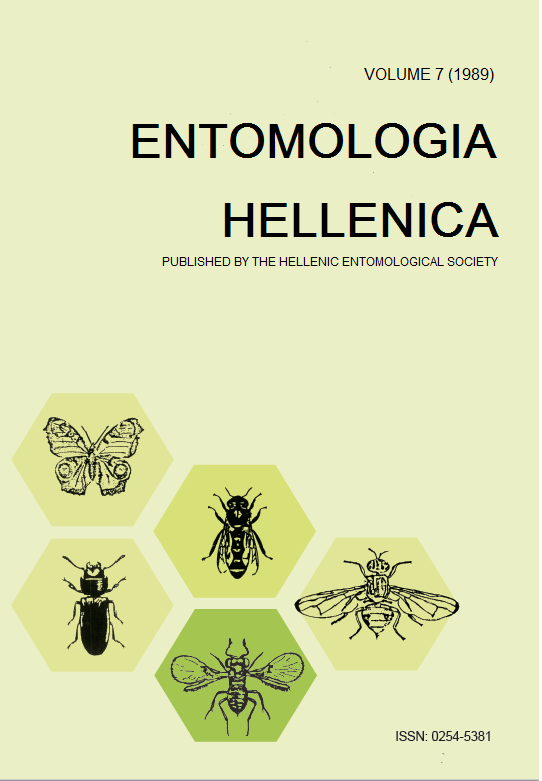Abstract
In many countries of Europe as well as in Greece a high percentage (40-70%) of the honey production derives from honeydew producing insects which belong to Hemiptem-Homoptera and mainly to the superfamilies Aphidoidea, Coccoidea, Psyloidea and Aleuroidea. To identify these useful to apiculture insects in Greece, a survey work has been carried out since 1977. From this research thirty eight species were observed and listed in the period of 1977-1983. Fifty eight species producing honeydew exploited by bees have been also observed in Central Europe. At least 120 species of honeydew producing insects (Rhynchota), on various host plants, have been recorded in Greece, therefore the number of insects useful to apiculture might be higher. This work aimed at finding more sources of honey production in our country and for this reason a survey was carried out in many areas to collect and identify the honeydew producing insects on which bees were observed to forage. The work was based on the method used previously. For that, sampling was carried out everywhere bees were observed to forage on insects honeydew. Bees were captured and examined according to the method described by Gary and Lorenzen to find out if and when the bees forage on this honeydew. The data collected during this period, 1984 to 1989, are recorded in this note. List of Species: I) Aphidoidea: A) Aphididae: 1) Acyrthosiphon caraganae (Cholodkovsky) (Aphidinae). It was found on the shrub Colutea arborescens L. at Portaria, Pelion, in May 1986. The bees forage from late April to June. This host plant exists almost all over Greece, but in high numbers in Peloponnesus, Sterea Hellas and Thessaly. A. caraganae was found in all these areas, while the bees were observed to forage on this aphid. 2) Corylobium avellanae (Schrank) (Aphidinae). It was observed on filbert trees (Corylus avellana L.) in the Grevena area in 1984 and later in Aghia, Larissa co. and Katerini, Pieria co. It is found on the under side of the leaf and produces honeydew from May to mid July. 3) Hyalopterus ainvgdafi (Blanchard) (Aphidinae). This aphid appears at high population levels on almond trees (Prunus dulcis (Miller) D.A. Webb.) in Locrida and Attiki (Central Greece) and on the island of Kea. It produces large quantities of honeydew in May, June, July. B) Lachnidae: 1) Cinara juniperi (De Geer) (Cinarinae). It was observed on Juniperus spp. in Giona mountain, in May 1986, at an altitude where the fir trees grow. The bees forage from May to early June. This honeydew is produced earlier than that excreted by the coccid Physokerines hemicryphus Dalman which lives on fir trees, and is very useful to apiculture in Greece. There are indications that the existence of this aphid close to fir forests, is a prediction that the coccid P. hemicryphus is going to attain high populations at the same year, but this has to be verified. 2) Cinara tujufilina (del Guercio) (Cinarmae). This aphid was observed on ornamental Thuja spp. in Votanikos Athens and Kiphissia, Attiki in April 1984. The bees forage late in April to May. This insect is new to the Greek fauna. C) Drepanosiphidae: 1) Phyllaphis phagi (L.) (Phyllaphidinae). Common aphid on Fagus silvatica L. It was found almost everywhere this host exists as in the mountains of Iti, Tymphristos, Pelion, Vermion and others. This insect produces honeydew in May, June and July. 2) Pterocallis maculata (Von Heyden) (Drepanosiphinae). It was found at low population levels on Alnus q1tifinosa Garth. in the mountains Pelion and Olympus in Central Greece in May 1987. This aphid produces honeydew in May, June and July. 3) Tuberculoides eggleri Burnes (Drepanosiphinae). This aphid was found on various species of Quercus spp. on the mountains, Zeria, Kalidromon, Iti, Pelion and Olympus, at relatively small population levels. The honeydew appears in May. II) Coccoidea: A) Aclerdidae: 1) Aclerda berlesei Buffa. This scale insect was found in Korinthia in July 1988 on Arundo donor L.. later it was observed everywhere this host-plant was sampled as in Lamia, Tricalla, Larissa, Platamonas (Central Greece). The population of this insect is always in high levels and it produces large quantities of honeydew. The honeydew appears early in June and continues in July, August and early September. The bees forage on it, mainly in August. The honey from this honeydew has good appearance, good taste but has not so good smell. B) Coccidae 1) Physokertnes piceae Schrank. This scale was recently found at low population levels on fir trees in Parnassus and Giona mountains in Central Greece and this is the first record in Greek fauna. All, but Aclerda berlesei, abovementioned species are recorded also in Central Europe as honeydew producing insects. It seems that amongst these ten honeydew producing insects, the most important for the apiculture of Greece are the aphid C. juniperi and the scale A. berlesei.




